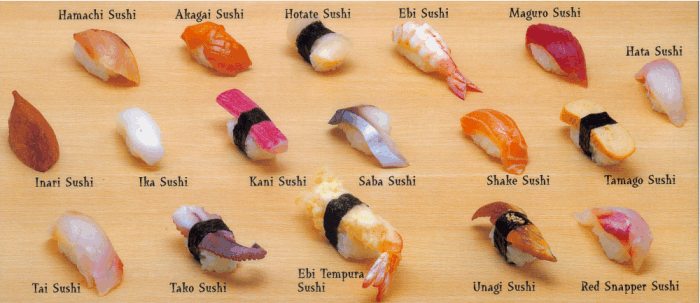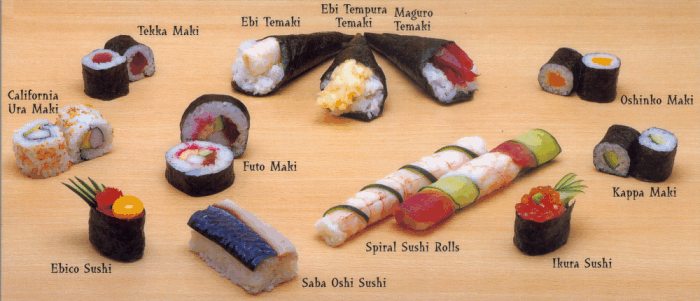 Sushi may roughly classified into the three kinds of Nara-zushi, Nama-Nari-zushi (also called Nama-Nare-zushi) and Haya-zushi.
It is true that sushi is one of the representative foods of Japan today, but its orgin is found in China at the end of 2nd century A.D. It was salted fish meat fermented in unpolished or polished rice. In those days, only the fish meat was eaten. The rice was discarded. This type of sushi called Nare-zushi in Japan. Its fermented time could be 1 to 3 years long.
During the 15th centry, Nama-Nari-zushi was developed. It is not fermented as long as Nare-zushi. After one month's fermentation, the fish was still raw. However, its taste was beginning to become mellow as a result of the fermentation. For the first time, RICE has been eaten with the fish. Nare-zushi and Nama-Nari-Zushi are used stone weight to ferment.
In the 16th centry, Sake-zushi, Bara-zushi and Saba-zushi was developed. These are still Nama-Nari-zushi. Sake-zushi was made for those who whising to view the cherry blossoms in spring. It's used sweet rice wine and pink to mix rice. Bara-zushi was made on the spring festival. Both Sake-zushi and Bara-zushi are looked like today's Chirashi-zushi. Fish, shellfish and vegetables were laid with rice alternately. Saba-zushi is marckel soaked in vinegar at first. Then, rolled with rice in a cloth by hand. This would much later lead to different types of sushi -- Rolled in bamboo mats or hand formed.
In the middle of 17th centry, rice VINEGAR was the first time used in sushi making. The purpose of using vinegar is shortening the fermentation time. It's also enriched the flavor of sushi. This is the beginning time of the Haya-zushi. Hako-zushi or box sushi, which is also called Osaka-zushi, was developed in this period of time in Osaka city. "Hako" in Japanese means box. Hako-zushi was sliced and salted fish packed with vinegared rice in a wooden box and placing a stone weight over on it. After one night's fermentation, it would be cut in rectangled shapes and consumed in the next day. Hako-zushi is still very popular in today's Japan.
In the early 19th century, in Tokyo. Nigiri-zushi made its debut. Nigiri-zushi is also a major development of Haya-zushi since the 17th century. It completely changed the traditional image of sushi. Nigiri-zushi is the most popular hand-formed sushi we are seeing in today's restuarants outside of Japan. It is a piece of fish on the top the sushi rice. Before Nigiri-zushi was developed, Nori-Maki-zushi appeared in the end of 18th centry. Its short term is Nori-Maki. This is the Maki-roll or roll which we often see in the restaurants. It's using a bamboo mat instead of using the stone weight.
Tokyo city was called Edo ciity in the old days. After WW2, "Edomae-zushi", this term has been used untill today. Because all fish and shellfish was caught from Tokyo Bay and people wanted to cerdit the bay. Nowadays, very few of the fish has been caught from the bay. Nigiri-zushi is not really the synonym of Edomae-zushi.
Heir to the Samurai Tradition
The spirit of sushi is carried on over the centuries by "shokunin" (traditional master sushi chef).
The Japanese are great believers in learning through apprenticeship. Before you are even allowed to pick up a knife you must work in the kitchen sweeping, doing dishes and other jobs for at least a couple of years. It may take ten years of training to be considered a master and become the head chef.
The sushi chef is heir to the samurai tradition and uphold the ideals of the samurai- they are scholastic and gentlemen of high personal standards and unshakable self-discipline. They wear spotless ghi's and a knotted headband, evidence that he is serious about his work.
Sushi is considered an art and in a country where cooking is highly regarded as a profession, to be a sushi chef is considered an honor.
Tools
A sushi man's knives are as important to him as a sword is to a samurai. His knives are made from carbon-steel that can be sharpened to literally cut a hair.
A sushi man has his own set of knives which can cost several hundred dollars apiece. He sharpens them before and after use, cleans them after every few strokes, and wraps them up and keeps them in a safe place every night.
Contrary to most knives, sushi knives are sharpened on one side only which makes for a faster, cleaner cut.
**Refference of this page:
Book: Sushi (Delicate Flavor of Japan) By Masuo Yoshino ISBN 4-05-151404-8

|

